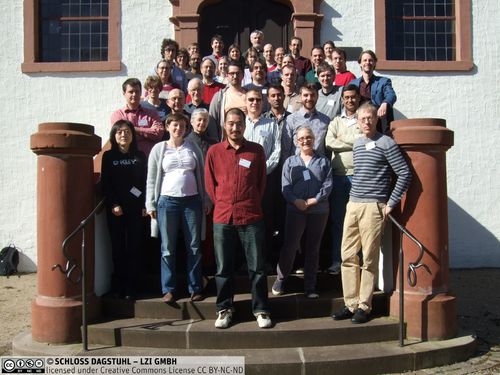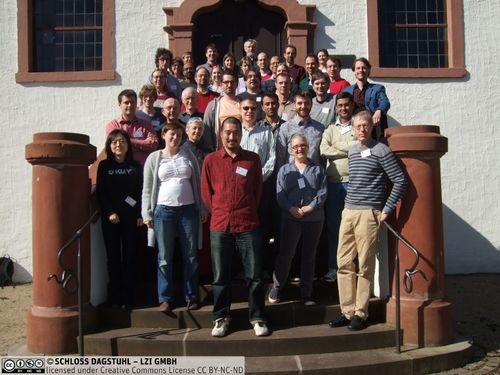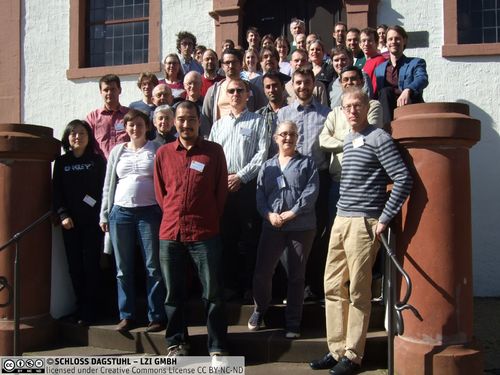Dagstuhl-Seminar 15111
Computational Geometry
( 08. Mar – 13. Mar, 2015 )
Permalink
Organisatoren
- Otfried Cheong (KAIST - Daejeon, KR)
- Jeff Erickson (University of Illinois - Urbana-Champaign, US)
- Monique Teillaud (INRIA Lorraine - Nancy, FR)
Kontakt
- Andreas Dolzmann (für wissenschaftliche Fragen)
- Susanne Bach-Bernhard (für administrative Fragen)
Programm
Computational geometry is concerned with the design, analysis, and implementation of algorithms for geometric and topological problems, which arise naturally in a wide range of areas, including computer graphics, robotics, geographic information systems, molecular biology, sensor networks, machine learning, data mining, scientific computing, theoretical computer science, and pure mathematics. Computational geometry is a vibrant and mature field of research, with several dedicated international conferences and journals, significant real-world impact, and strong intellectual connections with other computing and mathematics disciplines.
The emphasis of the seminar will be on presenting recent developments in computational geometry, as well as identifying new challenges, opportunities, and connections to other fields of computing. In addition to the usual broad coverage of emerging results in the field, the seminar will include invited survey talks on two broad and overlapping focus areas that cover a wide range of both theoretical and practical issues in geometric computing. Both focus areas have seen exciting recent progress and offer numerous opportunities for further cross-disciplinary impact.
Computational topology. Over the last decade, computational topology has grown from an important subfield of computational geometry into a mature research area in its own right. Results in this field combine classical mathematical techniques from combinatorial, geometric, and algebraic topology with algorithmic tools from computational geometry and optimization. Key developments in this area include algorithms for modeling and reconstructing surfaces from point-cloud data, algorithms for shape matching and classification, topological graph algorithms, new generalizations of persistent homology, practical techniques for experimental low-dimensional topology, and new fundamental results on the computability and complexity of embedding problems. These results have found a wide range of practical applications in computer graphics, computer vision, robotics, sensor networks, molecular biology, data analysis, and experimental mathematics.
Geometric data analysis. Geometric data sets are being generated at an unprecedented scale from many different sources, including digital video cameras, satellites, sensor networks, and physical simulations. The need to manage, analyze, and visualize dynamic, large-scale, high-dimensional, noisy data has raised significant theoretical and practical challenges not addressed by classical geometric algorithms. Key developments in this area include new computational models for massive, dynamic, and distributed geometric data; new techniques for effective dimensionality reduction; approximation algorithms based on coresets and other sampling techniques; algorithms for noisy and uncertain geometric data; and geometric algorithms for information spaces. Results in this area draw on mathematical tools from statistics, linear algebra, functional analysis, metric geometry, geometric and differential topology, and optimization, and they have found practical applications in spatial databases, clustering, shape matching and analysis, machine learning, computer vision, and scientific visualization.
Computational Geometry
Computational geometry is concerned with the design, analysis, and implementation of algorithms for geometric and topological problems, which arise naturally in a wide range of areas, including computer graphics, robotics, geographic information systems, molecular biology, sensor networks, machine learning, data mining, scientific computing, theoretical computer science, and pure mathematics. Computational geometry is a vibrant and mature field of research, with several dedicated international conferences and journals, significant real-world impact, and strong intellectual connections with other computing and mathematics disciplines.
Seminar Topics
The emphasis of the seminar was on presenting recent developments in computational geometry, as well as identifying new challenges, opportunities, and connections to other fields of computing. In addition to the usual broad coverage of emerging results in the field, the seminar included invited survey talks on two broad and overlapping focus areas that cover a wide range of both theoretical and practical issues in geometric computing. Both focus areas have seen exciting recent progress and offer numerous opportunities for further cross-disciplinary impact.
Computational topology and topological data analysis.
Over the last decade, computational topology has grown from an important subfield of computational geometry into a mature research area in its own right. Results in this field combine classical mathematical techniques from combinatorial, geometric, and algebraic topology with algorithmic tools from computational geometry and optimization. Key developments in this area include algorithms for modeling and reconstructing surfaces from point-cloud data, algorithms for shape matching and classification, topological graph algorithms, new generalizations of persistent homology, practical techniques for experimental low-dimensional topology, and new fundamental results on the computability and complexity of embedding problems. These results have found a wide range of practical applications in computer graphics, computer vision, robotics, sensor networks, molecular biology, data analysis, and experimental mathematics.
Geometric data analysis.
Geometric data sets are being generated at an unprecedented scale from many different sources, including digital video cameras, satellites, sensor networks, and physical simulations. The need to manage, analyze, and visualize dynamic, large-scale, high-dimensional, noisy data has raised significant theoretical and practical challenges not addressed by classical geometric algorithms. Key developments in this area include new computational models for massive, dynamic, and distributed geometric data; new techniques for effective dimensionality reduction; approximation algorithms based on coresets and other sampling techniques; algorithms for noisy and uncertain geometric data; and geometric algorithms for information spaces. Results in this area draw on mathematical tools from statistics, linear algebra, functional analysis, metric geometry, geometric and differential topology, and optimization, and they have found practical applications in spatial databases, clustering, shape matching and analysis, machine learning, computer vision, and scientific visualization.
Participants.
Dagstuhl seminars on computational geometry have been organized in a two year rhythm since a start in~1990. They have been extremely successful both in disseminating the knowledge and identifying new research thrusts. Many major results in computational geometry were first presented in Dagstuhl seminars, and interactions among the participants at these seminars have led to numerous new results in the field. These seminars have also played an important role in bringing researchers together, fostering collaboration, and exposing young talent to the seniors of the field. They have arguably been the most influential meetings in the field of computational geometry.
The organizers held a lottery for the second time this year; the lottery allows to create space to invite younger researchers, rejuvenating the seminar, while keeping a large group of senior and well-known scholars involved. Researchers on the initial list who were not selected by the lottery were notified by us separately per email, so that they knew that they were not forgotten, and to reassure them that---with better luck---they will have another chance in future seminars. The seminar has now a more balanced attendance in terms of seniority and gender than in the past.
This year, 41 researchers from various countries and continents attended the seminar, showing the strong interest of the community for this event. The feedback from participants was very positive.
No other meeting in our field allows young researchers to meet with, get to know, and work with well-known and senior scholars to the extent possible at the Dagstuhl Seminar.
We warmly thank the scientific, administrative and technical staff at Schloss Dagstuhl! Dagstuhl allows people to really meet and socialize, providing them with a wonderful atmosphere of a unique closed and pleasant environment, which is highly beneficial to interactions. Therefore, Schloss Dagstuhl itself is a great strength of the seminar.
 Otfried Cheong, Jeff Erickson, and Monique Teillaud
Otfried Cheong, Jeff Erickson, and Monique Teillaud
- Peyman Afshani (Aarhus University, DK) [dblp]
- Annamaria Amenta (University of California - Davis, US) [dblp]
- Franz Aurenhammer (TU Graz, AT) [dblp]
- Maike Buchin (Ruhr-Universität Bochum, DE) [dblp]
- Sergio Cabello (University of Ljubljana, SI) [dblp]
- Siu-Wing Cheng (HKUST - Kowloon, HK) [dblp]
- Otfried Cheong (KAIST - Daejeon, KR) [dblp]
- Jinhee Chun (Tohoku University - Sendai, JP) [dblp]
- Mark de Berg (TU Eindhoven, NL) [dblp]
- Vin de Silva (Pomona College - Claremont, US) [dblp]
- Olivier Devillers (INRIA Lorraine - Nancy, FR) [dblp]
- Tamal K. Dey (Ohio State University - Columbus, US) [dblp]
- Michael Gene Dobbins (Postech - Pohang, KR) [dblp]
- Anne Driemel (TU Eindhoven, NL) [dblp]
- Ioannis Emiris (University of Athens, GR) [dblp]
- Jeff Erickson (University of Illinois - Urbana-Champaign, US) [dblp]
- Jie Gao (SUNY - Stony Brook, US) [dblp]
- Marc Glisse (INRIA Saclay - Île-de-France, FR) [dblp]
- Leonidas J. Guibas (Stanford University, US) [dblp]
- Michael Kerber (MPI für Informatik - Saarbrücken, DE) [dblp]
- David G. Kirkpatrick (University of British Columbia - Vancouver, CA) [dblp]
- Rolf Klein (Universität Bonn, DE) [dblp]
- Joseph S. B. Mitchell (SUNY - Stony Brook, US) [dblp]
- Wolfgang Mulzer (FU Berlin, DE) [dblp]
- Elizabeth Munch (University of Albany, US) [dblp]
- Yota Otachi (JAIST - Ishikawa, JP) [dblp]
- Jeff M. Phillips (University of Utah - Salt Lake City, US) [dblp]
- Natan Rubin (Ben Gurion University - Beer Sheva, IL) [dblp]
- Vera Sacristán Adinolfi (UPC - Barcelona, ES) [dblp]
- Maria Saumell (University of West Bohemia - Pilsen, CZ) [dblp]
- Ludmila Scharf (FU Berlin, DE) [dblp]
- André Schulz (Universität Münster, DE) [dblp]
- Raimund Seidel (Universität des Saarlandes, DE) [dblp]
- Donald Sheehy (University of Connecticut - Storrs, US) [dblp]
- Jonathan Shewchuk (University of California - Berkeley, US) [dblp]
- Anastasios Sidiropoulos (Ohio State University - Columbus, US) [dblp]
- Fabian Stehn (Universität Bayreuth, DE) [dblp]
- Monique Teillaud (INRIA Lorraine - Nancy, FR) [dblp]
- Csaba Tóth (California State University - Northridge, US) [dblp]
- Carola Wenk (Tulane University, US) [dblp]
- Nicola Wolpert (University of Applied Sciences - Stuttgart, DE) [dblp]
Verwandte Seminare
- Dagstuhl-Seminar 9041: Algorithmic Geometry (1990-10-08 - 1990-10-12) (Details)
- Dagstuhl-Seminar 9141: Computational Geometry (1991-10-07 - 1991-10-11) (Details)
- Dagstuhl-Seminar 9312: Computational Geometry (1993-03-22 - 1993-03-26) (Details)
- Dagstuhl-Seminar 9511: Computational Geometry (1995-03-13 - 1995-03-17) (Details)
- Dagstuhl-Seminar 9707: Computational Geometry (1997-02-10 - 1997-02-14) (Details)
- Dagstuhl-Seminar 99102: Computational Geometry (1999-03-07 - 1999-03-12) (Details)
- Dagstuhl-Seminar 01121: Computational Geometry (2001-03-18 - 2001-03-23) (Details)
- Dagstuhl-Seminar 03121: Computational Geometry (2003-03-16 - 2003-03-21) (Details)
- Dagstuhl-Seminar 05111: Computational Geometry (2005-03-13 - 2005-03-18) (Details)
- Dagstuhl-Seminar 07111: Computational Geometry (2007-03-11 - 2007-03-16) (Details)
- Dagstuhl-Seminar 09111: Computational Geometry (2009-03-08 - 2009-03-13) (Details)
- Dagstuhl-Seminar 11111: Computational Geometry (2011-03-13 - 2011-03-18) (Details)
- Dagstuhl-Seminar 13101: Computational Geometry (2013-03-03 - 2013-03-08) (Details)
- Dagstuhl-Seminar 17171: Computational Geometry (2017-04-23 - 2017-04-28) (Details)
- Dagstuhl-Seminar 19181: Computational Geometry (2019-04-28 - 2019-05-03) (Details)
- Dagstuhl-Seminar 21181: Computational Geometry (2021-05-02 - 2021-05-07) (Details)
- Dagstuhl-Seminar 23221: Computational Geometry (2023-05-29 - 2023-06-02) (Details)
- Dagstuhl-Seminar 25201: Computational Geometry (2025-05-11 - 2025-05-16) (Details)
Klassifikation
- data structures / algorithms / complexity
Schlagworte
- Computational Geometry
- Geometry
- Topology
- Discrete Geometry




 Creative Commons BY 3.0 Unported license
Creative Commons BY 3.0 Unported license
